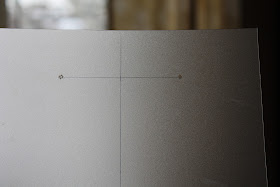This recipe is totally natural, you can use it for any wood in your home, including butcher block cutting boards and counter tops. So if you have leftover finish, polish up your house!
What you need:
A hunk of beeswax
A bottle of mineral oil
An old sock or thread bare dish towel, or whatever application rag floats your boat.
A pan or pot (one you aren't using for food that will work as a double boiler top)
A plastic scraper of some sort (I used an offset painters knife)
Sandpaper
Step One:
Give your project a good sanding. I went all the way to 600 grit because I didn't want my rag snagging in the wood grain when I was applying the finish. But, this was total overkill. Go to 220 and you will be just fine.
Step Two:
Make the finish. I used a 60/40 ratio of mineral oil to beeswax. You can adjust the proportions to get the consistency you like. Too hard? Reheat and add more mineral oil. Too soft? Reheat and add more beeswax. Tip: harder is better for jobs like protecting and lubricating saw blades (rub it on the teeth of your backsaw and cut some dovetails. So awesome.)
Using a double boiler (your junky pan on top of the pot you are using to boil the water in), melt your beeswax. Add the mineral oil (sidebar: cool science, the mineral oil solidifies as soon as it hits the beeswax! Neat!). Stir well with whatever you have on hand (a paint stick or scrap sticks work nicely). When the mixture is thoroughly blended and all clear, remove from heat and take to your workplace.
Step Three:
I let the mixture cool for a few minutes and then used a plastic painters knife to mix it around, scraping the sides of the pan as I went and keeping the mixture together in a blob. Once it was cool enough to handle, I put a dollop inside an old sock. The mixture squished out of the threadbare sock so I could apply it lightly and evenly to the whole board.
Step Four
Apply the beeswax and mineral oil mixture onto your project by rubbing it on in small circles. Just look at the difference already!! So shiny!
 |
Now you just have to wait a bit. Once you have applied your wax to the entire board, it will look like the photo below. All shiny with small swirls still visible. I went inside to eat some dinner while my wax soaked in to the board.
 | |||||||||||||
Buff! Get a clean sock or another disposable soft clean rag and buff the piece in small circles. The excess wax will ball up as you go. Keep refolding the clean rag so you are actually buffing excess off instead of just spreading it around.
Step Seven
Admire your work! This board is so smooth, and water beads up on it so nicely! I wish I had butcher block counters so I could use more wax in my house!
More uses!
Our family got the toboggan out today so we could go hunt wood in the forest. I wanted to find some great old stumps for another project I am working on. Our large toboggan had certainly seen better days - the wood was flaking and in terrible shape. Enter the leftover mixture I had from this post. That toboggan has NEVER looked better, and it slid along the snow like butter on butter. So, if you have an old sled laying around that needs some love - give it the beeswax and mineral oil treatment!
How did this work for you?





















